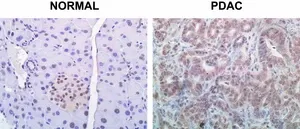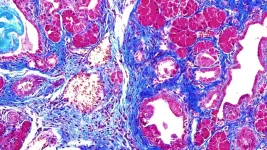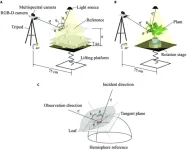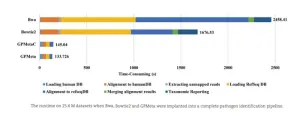(Press-News.org) Using hydrophones to eavesdrop on a reef off the coast of Goa, India, researchers have helped advance a new low-cost way to monitor changes in the world’s murky marine environments.
Reporting their results in the Journal of the Acoustical Society of America (JASA), the scientists recorded the duration and timing of mating and feeding sounds – songs, croaks, trumpets and drums – of 21 of the world’s noise-making ocean species.
With artificial intelligence and other pioneering techniques to discern the calls of marine life, they recorded and identified
a medium sized “grunter,” loudest at dusk, Terapon theraps (photo, right, at eol.org/media/15232663l audio https://bit.ly/41LQmn);
fish of the Sciaenidae family (audio: https://bit.ly/3KWtawy);
choruses of plankton-eating fish species (audio: https://bit.ly/3oAsGo5); and
snapping shrimp (audio: https://bit.ly/3mTQ0gd), including commercially-valuable tiger prawns.
Some species within the underwater community work the early shift and ruckus from 3 am to 1.45 pm, others work the late shift and ruckus from 2 pm to 2.45 am, while the plankton predators were “strongly influenced by the moon.”
Also registered: the degree of difference in the abundance of marine life before and after a monsoon.
The paper concludes that hydrophones are a powerful tool and “overall classification performance (89%) is helpful in the real-time monitoring of the fish stocks in the ecosystem.”
The team, including Bishwajit Chakraborty, a leader of the International Quiet Ocean Experiment (IQOE), benefitted from archived recordings of marine species against which they could match what they heard, including:
A cacophony of spawning tiger perch: (audio: https://bit.ly/3LkZYkj), and
Snapping shrimp (audio: https://bit.ly/41NZWH2), whose sounds baby oysters reportedly like to follow
Also captured was a “buzz” call of unknown origin (https://bit.ly/3GZdRSI), one of the oceans’ countless marine life mysteries.
With a contribution to the International Quiet Ocean Experiment, the research will be discussed at an IQOE meeting in Woods Hole, MA, USA, 26-27 April.
Advancing the Global Library of Underwater Biological Sounds (GLUBS)
That event will be followed April 28-29 by a meeting of partners in the new Global Library of Underwater Biological Sounds (GLUBS), a major legacy of the decade-long IQOE, ending in 2025.
GLUBS, conceived in late 2021 and currently under development, is designed as an open-access online platform to help collate global information and to broaden and standardize scientific and community knowledge of underwater soundscapes and their contributing sources.
It will help build short snippets and snapshots (minutes, hours, days long recordings) of biological, anthropogenic, and geophysical marine sounds into full-scale, tell-tale underwater baseline soundscapes.
Especially notable among many applications of insights from GLUBS information: the ability to detect in hard-to-see underwater environments and habitats how the distribution and behavior of marine life responds to increasing pressure from climate change, fishing, resource development, plastic, anthropogenic noise and other pollutants.
“Passive acoustic monitoring (PAM) is an effective technique for sampling aquatic systems that is particularly useful in deep, dark, turbid, and rapidly changing or remote locations,” says Miles Parsons of the Australian Institute of Marine Science and a leader of GLUBS.
He and colleagues outline two primary targets:
Produce and maintain a list of all aquatic species confirmed or anticipated to produce sound underwater;
Promote the reporting of sounds from unknown sources
Odd songs of Hawaii’s mystery fish
In this latter pursuit, GLUBS will also help reveal species unknown to science as yet and contribute to their eventual identification.
For example, newly added to the growing global collection of marine sounds are recent recordings from Hawaii, featuring the baffling
Mystery fish 1 (audio: https://bit.ly/3LjHDUJ),
2 (audio: https://bit.ly/3UW24u0), and
3 (audio: https://bit.ly/3KWtVpo),
now part of an entire YouTube channel (https://bit.ly/3H5Ly54) dedicated to marine life sounds in Hawaii and elsewhere (e.g. this “complete and total mystery from the Florida Keys”: https://bit.ly/41w1Xbc (Annie Innes-Gold, Hawai'i Institute of Marine Biology; processed by Jill Munger, Conservation Metrics, Inc.)
Says Dr. Parsons: “Unidentified sounds can provide valuable information on the richness of the soundscape, the acoustic communities that contribute to it and behavioral interactions among acoustic groups. However, unknown, cryptic and rare sounds are rarely target signals for research and monitoring projects and are, therefore, largely unreported.”
The many uses of underwater sound
Of the roughly 250,000 known marine species, scientists think all fully-aquatic marine mammals (~146, including sub-species) emit sounds, along with at least 100 invertebrates, 1,000 of the world’s ~35,000 known fish species, and likely many thousands more.
GLUBS aims to help delineate essential fish habitat and estimate biomass of a spawning aggregation of a commercially or recreationally important soniferous species.
In one scenario of its many uses, a one-year, calibrated recording can provide a proxy for the timing, location and, under certain circumstances, numbers of ‘calling’ fishes, and how these change throughout a spawning season.
It will also help evaluate the degradation and recovery of a coral reef.
GLUBS researchers envision, for example, collecting recordings from a coral reef that experienced a cyclone or other extreme weather event, followed by widespread bleaching. Throughout its restoration, GLUBS audio data would be matched with and augment a visual census of the fish assemblage at multiple timepoints.
Oil and gas, wind power and other offshore industries will also benefit from GLUBS’ timely information on the possible harms or benefits of their activities.
* * * * *
Other IQOE legacies include:
Manta (bitbucket.org/CLO-BRP/manta-wiki/wiki/Home), a mechanism created by world experts from academia, industry, and government to help standardize ocean sound recording data, facilitating its comparability, pooling and visualization.
OPUS, an Open Portal to Underwater Sound being tested at Alfred Wegener Institute in Bremerhaven, Germany to promote the use of acoustic data collected worldwide, providing easy access to MANTA-processed data, and
The first comprehensive database and map of the world’s 200+ known hydrophones recording for ecological purposes
* * * * *
Marine sounds and COVID-19
The IQOE’s early ambition of humanity’s maritime noise being minimized for a day or week was unexpectedly met in spades when the COVID-19 pandemic began.
New IQOE research to be considered at the April meeting includes a paper, Impact of the COVID‑19 pandemic on levels of deep‑ocean acoustic noise (https://bit.ly/3KZTaIt) documenting a pandemic-related drop of 1 to 3 dB even in the depths of the abyss. With a 3 dB decrease, sound energy is halved.
Virus control measures led to “sudden and sometimes dramatic reductions in human activity in sectors such as transport, industry, energy, tourism, and construction,” with some of the greatest reductions from March to June 2020 – a drop of up to 13% in container ship traffic and up to 42% in passenger ships.
Other IQOE accomplishments include achieving recognition of ocean sound as an Essential Ocean Variable (EOV) within the Global Ocean Observing System, underlining its helpfulness in monitoring
climate change (the extent and breakup of sea ice; the frequency and intensity of wind, waves and rain)
ocean health (biodiversity assessments: monitoring the distribution and abundance of sound-producing species)
impacts of human activities on wildlife, and
nuclear explosions, foreign/illegal/threatening vessels, human activities in protected areas, and underwater earthquakes that can generate tsunamis
The Partnership for Observation of the Global Ocean (POGO) funded an IQOE Working Group in 2016, which quickly identified the lack of ocean sound as a variable measured by ocean observing systems. This group developed specifications for an Ocean Sound Essential Ocean Variable (EOV) by 2018, which was approved by the Global Ocean Observing System in 2021. IQOE has since developed the Ocean Sound EOV Implementation Plan, reviewed in 2022 and ready for public debut at IQOE’s meeting April 26.
* * * * *
One of IQOE’s originators, Jesse Ausubel of The Rockefeller University’s Programme for the Human Environment, says the programme has drawn attention to the absence of publicly available time series of sound on ecologically important frequencies throughout the global ocean.
“We need to listen more in the blue symphony halls. Animal sounds are behavior, and we need to record and understand the sounds, if we want to know the status of ocean life,” he says.
The program “has provided a platform for the international passive acoustics community to grow stronger and advocate for inclusion of acoustic measurements in national, regional, and global ocean observing systems,” says Prof. Peter Tyack of the University of St. Andrew’s, who, with Steven Simpson, guide the IQOE International Scientific Steering Committee.
“The ocean acoustics and bioacoustics communities had no experience in working together globally, and coverage is certainly not global; there are many gaps. IQOE has begun to help these communities work together globally, and there is still progress to be made in networking and in expanding the deployment of hydrophones, adds Prof. Ausubel.
A description of the project’s history and evaluation to date is available at https://bit.ly/3H7FCbN.
* * * * *
Encouraging greater worldwide use of hydrophones
According to Dr. Parsons, “hydrophones are now being deployed in more locations, more often, by more people, than ever before,”
To celebrate that, and to mark World Oceans Day, June 8, GLUBS recently put out a call to hydrophone operators to share marine life recordings made from 7 to 9 June, so far receiving interest from 124 hydrophone operators in 62 organizations from 29 countries and counting. The hydrophones will be retrieved over the following months with the full dataset expected sometime in 2024.
They also plan to make World Oceans Passive Acoustic Monitoring (WOPAM) Day an annual event – a global collaborative study of aquatic soundscapes, salt, brackish or freshwater – the marine world’s answer to the U.S. Audubon Society’s 123-year-old Christmas Bird Count.
Interested researchers with hydrophones already planned to be in the water on June 8 are invited to contact Miles Parsons (m.parsons@aims.gov.au) or Steve Simpson (s.simpson@bristol.ac.uk).
END
Do fish bay at the moon? Can their odd songs identify Hawaiian mystery fish? Eavesdropping scientists progress in recording, understanding ocean soundscapes
2023-04-26
ELSE PRESS RELEASES FROM THIS DATE:
This killer protein causes pancreatic cancer
2023-04-26
Pancreatic ductal adenocarcinoma (PDAC) is the most common form of pancreatic cancer. It’s also one of the deadliest. More than 90% of PDAC patients die within five years of diagnosis. Usually, by the time the cancer is identified, it has already spread.
“PDAC is often found too late for treatments like chemotherapy and surgery to be very effective,” Cold Spring Harbor Laboratory (CSHL) Professor Adrian Krainer says. “But if we can clearly understand the underlying genetic mechanisms of PDAC, this might lead to earlier diagnoses and new types of therapies.”
Krainer ...
Novel ‘registration’ method identifies plant traits in close-up photos
2023-04-26
Modern cameras and sensors, together with image processing algorithms and artificial intelligence (AI), are ushering in a new era of precision agriculture and plant breeding. In the near future, farmers and scientists will be able to quantify various plant traits by simply pointing special imaging devices at plants. However, some obstacles must be overcome before these visions become a reality. A major issue faced during image-sensing is the difficulty of combining data from the same plant gathered from multiple image sensors, also known as ‘multispectral’ or ‘multimodal’ ...
Introducing GPMeta: Ultrarapid GPU-accelerated pathogen identification approach
2023-04-26
Metagenomic sequencing (mNGS) is a powerful diagnostic tool to detect causative pathogens in clinical microbiological testing. Rapid and accurate classification of metagenomic sequences is a critical procedure for pathogen identification in the dry-lab step of mNGS tests. However, this crucial step may be improved by classifying sequences within a clinically relevant timeframe.
To address this challenge, a BGI Genomics team led by Xuebin Wang has recently launched GPMeta, an ultra-fast pathogen detection approach, and published these highlights ...
Alarming rates of teen suicide continue to increase in the US
2023-04-26
In the United States suicide has become the second leading cause of premature death among those ages 10 to 24; it is the leading cause of death among teens ages 13 to 14.
Researchers from Florida Atlantic University’s Schmidt College of Medicine and collaborators conducted a study exploring trends in rates of suicide among 13 to 14 year olds in the U.S. from 1999 to 2018. They also explored possible modifications by sex, race, level of urbanization, census region, month of the year and day of the week.
Results, published online ahead of print in the journal Annals of Pediatrics and Child Health, showed that among children ages 13 to 14, suicide rates ...
Thinking About an Unconventional Spelling for Your New Product or Service? You May Want to Reconsider
2023-04-26
Researchers from University of Notre Dame and The Ohio State University published a new Journal of Marketing study that examines how the use of unconventional spellings of a brand name impacts consumers’ inferences about and willingness to support the brand.
The study, forthcoming in the Journal of Marketing, is titled “‘Choozing’ the Best Spelling: Consumer Response to Unconventionally Spelled Brand Names” and is authored by John P. Costello, Jesse Walker, and Rebecca Walker Reczek.
Choosing a brand ...
Degrading viral RNA to treat SARS-CoV-2 infection
2023-04-26
Development of vaccines against SARS-CoV-2 has been rapid, but the rise of variants forces scientists to frequently modify treatments. Ideally, therapies would target mutation-resistant viral proteins, but this has proven difficult. Researchers reporting in ACS Central Science, however, have now developed a system that directly targets and degrades the viral RNA genome, reducing infection in mice. The method could be adapted to fight off many viruses, as well as treat various diseases.
Vaccines and antiviral drugs typically target proteins critical to viral infection and replication. This ...
U.S. adults who felt discrimination at work faced increased risk of high blood pressure
2023-04-26
Research Highlights:
U.S. adults who reported feeling highly discriminated against at work had an increased risk of developing high blood pressure than those who reported low discrimination at work.
Researchers suggest government and employer anti-discrimination policies and interventions may help to eliminate discrimination in the workplace.
Embargoed until 4 a.m. CT/5 a.m. ET Wednesday, April 26, 2023
DALLAS, April 26, 2023 — U.S. adults who reported feeling discriminated against at work had a higher risk for developing high ...
Innovative treatment targets blood clots without increased bleeding risk
2023-04-26
Safer and more effective blood thinners could be on the way following a groundbreaking discovery by researchers at UBC and the University of Michigan, published today in Nature Communications.
By combining their expertise in blood clotting systems and chemical synthesis, the researchers have designed a new compound called MPI 8 that offers the potential to prevent blood clots without any increased risk of bleeding—a common side effect of existing blood thinners.
“The development of MPI 8 represents a major breakthrough in the field of blood clot prevention and treatment,” said Dr. Jay Kizhakkedathu, a professor and Canada Research ...
Researchers show genetic basis of facial changes in Down Syndrome
2023-04-26
Researchers at the Francis Crick Institute, King’s College London and University College London have shed light on the genetics behind changes in the structure and shape of the face and head in a mouse model of Down Syndrome.
Described in a paper published today in Development, the researchers found that having a third copy of the gene Dyrk1a and at least three other genes were responsible for these changes taking place in development – called craniofacial dysmorphology – which involve shortened back-to-front length and widened diameter of the head.
Affecting ...
Gestational weight gain z scores, standardized by pre-pregnancy BMI, associated with susceptibility to autism-related traits
2023-04-26
ROCKVILLE, Md.—Gestational weight gain may be associated with autism-related behaviors among children who have a greater pre-disposition to these behaviors and who have mothers with pre-pregnancy overweight or obesity, according to a new study in Obesity, The Obesity Society’s (TOS) flagship journal.
Excessive gestational weight gain has been associated with neurodevelopmental outcomes in children, including autism spectrum disorder and related traits. However, it is unclear how pre-pregnancy body mass index (BMI) or familial susceptibility to autism spectrum disorder influences the gestational weight gain-autism traits association, ...





